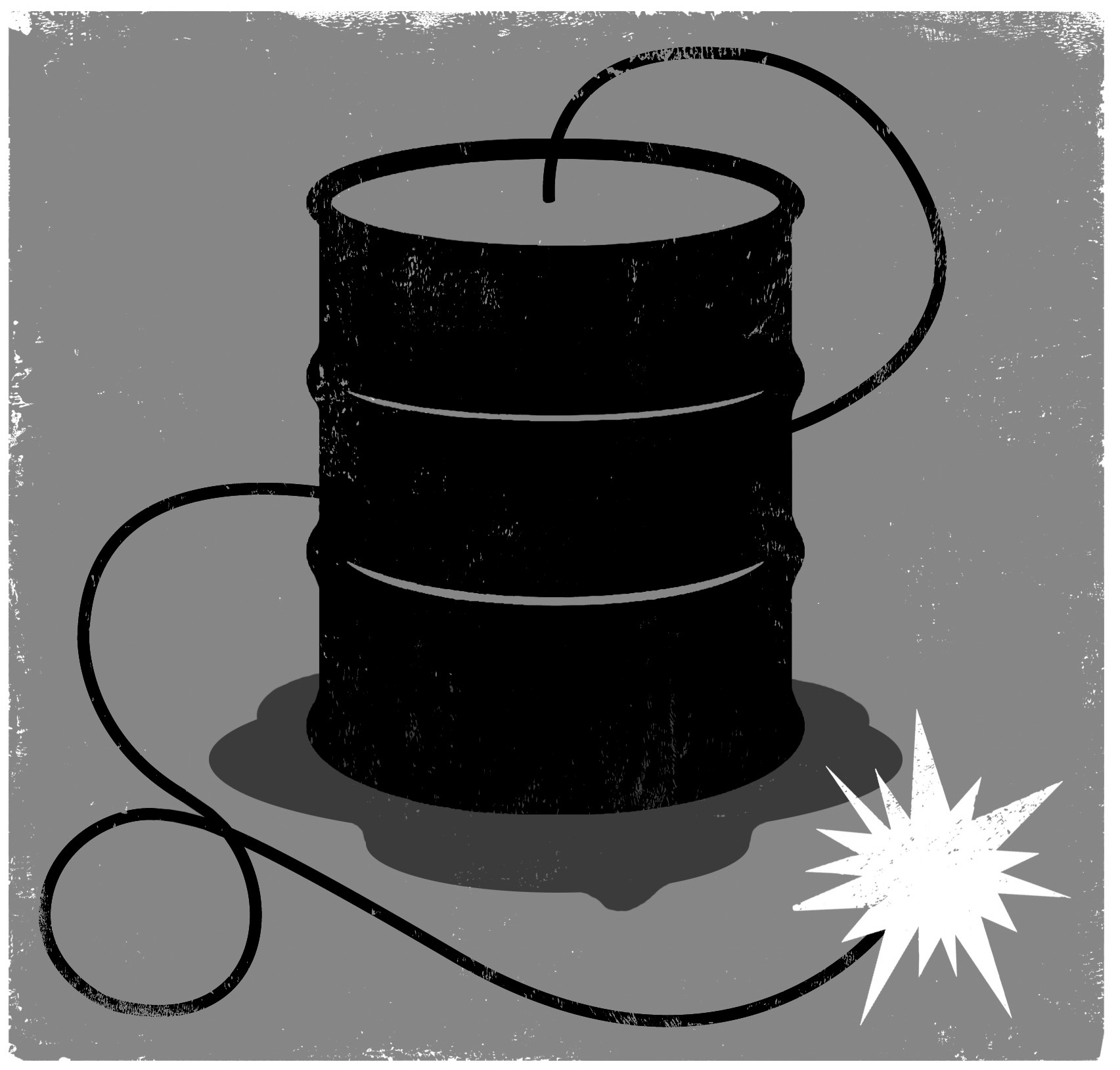 (Illustration: Edel Rodriguez)
(Illustration: Edel Rodriguez)
By the metrics of modern industrial catastrophes, the June 13 explosion at the Williams Olefins vinyl plant in Geismar, Louisiana, was a minor affair. Two men were killed. And 77 were injured. All the casualties were plant workers, no civilians killed or injured.
Governor Bobby Jindal arrived while the fire was still burning and held a press conference on a state highway, at a safe distance from the plant. He described the black plume billowing from a smokestack as routine, considering the circumstance: “mainly a hydrocarbon, not an inhalation hazard.”
Jindal promised “further investigations afterward to determine what happened to make sure this doesn’t happen again.”
There is a demographic truth about people who live with the collateral damage caused by chemical-plant and refinery accidents in this country: they are economically marginalized and almost always black or Hispanic.
The Louisiana Department of Environmental Quality began an investigation. The federal Occupational Safety and Health Administration began its own investigation. And life in Geismar returned to normal.
That is, normal for Geismar, a small town 20 miles south of Baton Rogue in an industrial corridor referred to as “Cancer Alley” or “Bhopal on the Bayou.” Geismar, to be precise, is not a town but a cluster of small rural communities on the northeast side of Louisiana State Highway 30 where it intersects with State Highway 73.
South of Highway 30, a mile-wide industrial zone extends to the levee on the Mississippi. Huntsman, Shell Chemical, BSAF, Rhone-Poulenc, Momentive Specialty Chemicals, Lion Copolymer, Williams Olefins and others occupy a contiguous stretch of land that provides easy access to terminal points on the east bank of the river.
West on Highway 30, the Potash Corporation of Saskatchewan’s 425-acre, snow-white gypsum mountain stands 140 feet high and provides Geismar with a dramatic western skyline. The contractor that maintains the stack reports it will “stack gyp to the permitted elevation of 200 feet, the same height as the State Capitol!”
Thirty minutes from Baton Rogue, an hour from New Orleans, and 10 minutes from Interstate 10, Geismar feels remote and isolated.
Crowdsourcing pollution
The Louisiana Bucket Brigade is a environmental group based in New Orleans. (Their “bucket” is a canister that individuals use to sample air pollution in their neighborhoods.) The brigade maintains an online crowdsourcing platform—the iWitness Pollution Map—that plant workers and residents of “fence communities” use to post locations and descriptions of chemical spills or accidents.
In late July, I followed the iWitness map to Geismar neighborhoods where residents posted reports on the day of the Williams Olefins explosion.
There is a demographic truth about people who live with the collateral damage caused by chemical-plant and refinery accidents in this country: they are economically marginalized and almost always black or Hispanic. And they live in concentric rings of chemical contamination in hundreds of small towns and cities.
In 16 interviews over two weekdays in Geismar, I did not encounter one white person. And every interview except one was done in a trailer home.
If there was a recurrent theme to these discussions, it is that when there is a critical failure in a chemical plant, you’re on your own.
In a neighborhood called Buzzaroot, on a street with no name, I asked a woman named Shannon Dorville to describe what happened on June 13.
“I don’t remember if the siren went off or not,” Dorville said. Neighborhoods in Geismar, like the local chemical plants, are studded with warning sirens mounted on utility poles, which are also equipped with speaker systems.
“But I sure heard the explosion,” Dorville told me. “It shook the trailer. Then I smelled it. It kind of bothered you in your throat and down in your chest after a while.”
“Nobody come out here to tell us what to do,” Dorville said. “We do what we always know to do. Get inside and close the doors and windows.”
At the dead end of the street where I spoke to Dorville, a tall, weathered 65-year-old man named Lawrence Earl Sr. told me he was working in his garden when the plant blew.
“I heard it, I saw it, smelled it,” Earl said.
Earl’s house, actually a large mobile home around which he appears to be building a wood frame house, is about a mile north of the Williams Olefins fence.
Earl said that soon after he saw the cloud over the plant, his eyes began to burn and he began to sneeze.
I asked him the same question I asked everyone I interviewed. Did a representative from the company, or the city or parish government, contact him?
There are 15 chemical plants and 17 refineries between Baton Rogue and New Orleans, in an industrial corridor often referred to as “Cancer Alley” or “Bhopal on the Bayou.”
“Beside you, nobody ever came out here to ask me anything,” Earl said. “You the first one.”
A half-mile from Buzzaroot, and five trailer houses down from the most forlorn municipal park I’ve ever seen, I stand in the driveway of a 51-year-old woman with a quiet demeanor and a beatific smile.
“They say the siren went off,” she said. “But that happens so frequently around here that you don’t know when it’s real and when it’s not real.”
“There was another one last year,” she said, referring to a September 2012 fire that released a cloud of ethane and propane. “But this one was bigger than you can imagine.”
“We were locked down,” she said. “All the highways were blocked. I wanted to get my mother out of here, but I couldn’t. So we closed the windows and turned off the air conditioner and stayed in the house, watching TV and trying to figure out what was happening.”
She and her 18-year-old daughter watched Jindal reassure the public that the air was safe to breath.
“He wasn’t standing here with me,” she said. “He went home to sleep in the Governor’s Mansion.”
She would leave Geismar, she said, if she were “financially able.”
Out of compliance
“There are 15 chemical plants between Baton Rouge and New Orleans,” the Bucket Brigade’s Program Director Anna Hrybyk told me. “And 17 refineries.”
Researchers at the Bucket Brigade analyzed reports filed with government agencies and found that plant managers in the region routinely underreport accidents, spills, and “upsets” (emissions that exceed permitted limits).
In 2012, for example, the environmental group blew the whistle on ExxonMobil’s Baton Rouge refinery after discovering its management had reported no accidents to the EPA in the previous five years, while reporting 100 accidents to state agencies.
A Congressional Research Service study released last year conforms with what Bucket Brigade researchers discovered: the Louisiana region includes the highest number of delinquent industrial facilities in the nation.
The Williams Olefins plant is one of them; it has been out of compliance with the Clean Air Act for the past three years. Its June 13 explosion is yet another infraction.
The smoke that drifted across Geismar after the explosion was not as benign as what Governor Jindal described.
Williams Olefins reported to the Louisiana Department of Environmental Quality that the explosion released 31,187 pounds of volatile organic carbon material, including 2,390 pounds of propylene; 2,398 pounds of ethylene; 5,621 pounds of other volatile organic compounds, including propane; 48 pounds of benzene; and 85 pounds of soot and particulate.
The Times-Picayune, which published the figures, described them as “conservative” estimates.
Finding a policy to fix the problem
In spring of 2012, the Environmental Protection Agency’s National Environmental Justice Advisory Council proposed a change in agency policy that would allow the residents of Geismar to breath easier.
NEJAC’s board chair wrote to then-EPA Administrator Lisa Jackson urging her to use the Clean Air Act’s “general duty clause” to require chemical plant managers to take specific actions, including the use of newer technology, to prevent catastrophic chemical leaks and explosions.
The general duty clause, also known as the Bhopal clause, was passed in response to the 1984 chemical disaster in Bhopal, India.
NEJAC’s proposal was immediately endorsed by Christine Todd Whitman, George W. Bush’s first EPA administrator. In 2003, Whitman had worked in collaboration with then-Secretary of Homeland Security Tom Ridge to draft legislation that would have provided statutory authority for the EPA to regulate chemical plant safety.
“That plan was killed by Dick Cheney’s son-in-law,” Rick Hind told me in a telephone interview. Hind is the legislative director for Greenpeace.
In 2003 Philip Perry, the husband of Elizabeth Cheney, was general counsel at the Office of Management and Budget. Perry informed Whitman and Ridge that the Bush administration would not support EPA regulatory authority over chemical plants (which was odd because Whitman and Ridge were part of the Bush administration).
The proposal, intended to make chemical plants safer in the event of terrorist attacks, was shelved. Whitman resigned four months later and Perry returned to the private sector to work for a law firm that represents the American Chemistry Council.
Whitman saw the NEJAC proposal as an opportunity to achieve what she failed to accomplish in 2003. In April 2012, she also wrote to then-EPA Director Lisa Jackson, urging her to issue a “finding” that would authorize the use of the general duty clause to extend the agency’s authority over chemical plants.
A finding would circumvent the rule-making process, which can take years of hearings before a rule is finalized. And a finding requires no congressional authorization.
What began with a letter from National Environmental Justice Advisory Council board has grown into a campaign supported by a coalition of 100 labor unions and environmental organizations.
“Chemical plants can be much safer,” said Greenpeace’s Hind. “Obviously, not 100 percent safe. But commercial airlines are much safer today than they were 40 years ago because of regulation.”
The green-labor coalition is asking for a finding that would authorize the EPA to make plants “inherently safer by reducing quantities of hazardous chemicals handled or stored, substituting less hazardous chemicals for extremely hazardous ones, or otherwise modifying the design or process to reduce or eliminate chemical hazards.”
An initial response to the campaign came in a March 2012 letter from Louisiana Senators David Vitter (R) and Mary Landrieu (D), informing Jackson that current regulations are adequate and that using the general duty clause of the Clean Air Act would be “duplicative, confusing, and could potentially conflict with…current regulatory systems.” Senators Jim Inhofe (R-OK) and Susan Collins (R-ME) also signed the letter.
In March of this year, Congressman Mike Pompeo (R-KS) filed a “General Duty Clause Clarification Bill” that would strip the EPA’s authority to use the clause to regulate chemical-plant safety. “There is no secret who is behind the bill,” Hind said.
Pompeo represents the Kansas district that is home to Koch Industries. A Greenpeace study found that over the past five years, 45 lobbyists hired by Koch have joined Koch’s in-house lobby team to work on chemical-safety issues.
The industry campaign is larger than Koch Industries. Twenty-five trade associations, including the American Chemistry Council, the American Petroleum Institute and the U.S. Chamber of Commerce have signed onto a letter that warns of “arbitrary EPA enforcement of federal regulations” if Pompeo’s bill isn’t passed.
“We have a small window now that Gina McCarthy is confirmed,” Hind said.
Vitter had held up Senate confirmation of EPA Administrator McCarthy for 135 days, in part because he wanted a commitment that she would not use the general duty clause to regulate chemical plants. (McCarthy avoided responding to Vitter.)
The political dynamics of this fight are Manichean: either the chemical industry or residents of at-risk communities like Geismar will prevail.
On August 2, the White House issued an executive order that directed state and federal agencies to coordinate their work on chemical-plant safety.
Still missing is the authority that would come with a finding issued by the administrator of the EPA.
Lou Dubose is the editor of The Washington Spectator




0 Comments